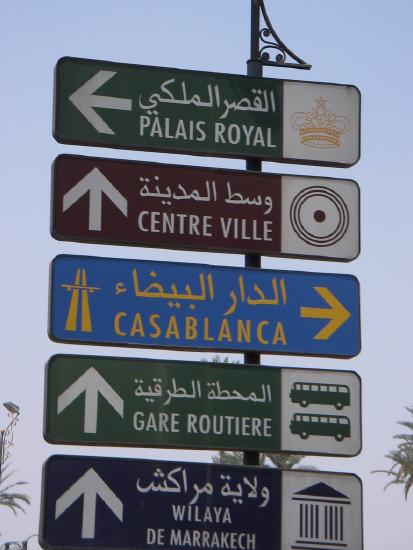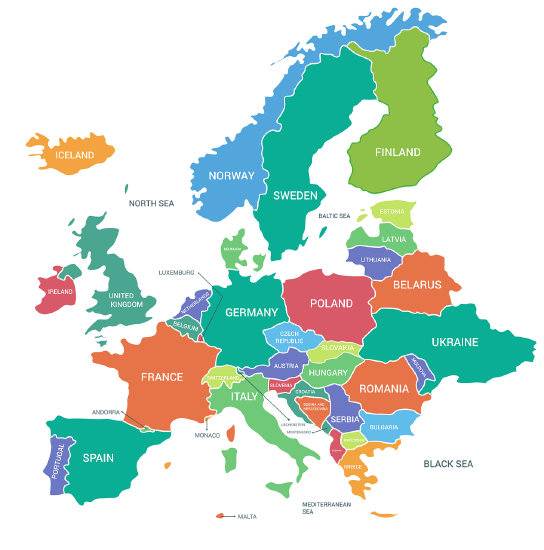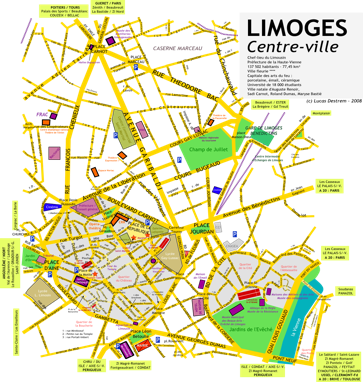5.3: Où se trouve ... ?
- Page ID
- 118934
In this section, you will learn how to ask and describe where things are located in town
Listen to the audio clips that follow on this page to hear the French pronunciation of vocabulary and examples presented.
On étudie !


You just arrived in a new city and you want to know where things are and how to get there.
(a) To ask where something is you can say the following:
| Français | Anglais | Français | Anglais |
|---|---|---|---|
| Où se trouve... ? | Where is...? | Où se trouvent.... ? | Where are...? |
| Où est... ? | Où sont... ? | ||
| C'est où... ? | C'est où...? | ||
| Il, elle est où... ? | Ils, elles sont où... ? |
Où se trouve la poste ? (Where is the post office?)
Où se trouvent les bibliothèques ? (Where are the libraries?)
Où est l'office de tourisme ? (Where is the office of tourism?)
Où sont les écoles ? (Where are the schools?)
(b) To answer these questions, use the following:
| Français | Anglais | Français | Anglais |
|---|---|---|---|
| C'est... | It's... | Ce sont... | They are... |
| Il/Elle est... | It's... | Ils/Elles sont... | They are... |
— Où se trouve la librairie ? (Where is the bookstore?)
— Elle est à côté du restaurant. (It's next to the restaurant.)
— C'est où la bibliothèque ? (Where is the library?)
— C'est derrière le musée. (It's behind the museum.)
— Où sont les toilettes ? (Where are the bathrooms?)
— Elles sont par là. (They're over there.)

La carte d'Europe
"This work" by Max Pixel is in the Public Domain, CC0

Le plan de Limoge
"This work" by Babsy, Wikimedia Commons is licensed under CC BY 3.0
| Français | Anglais |
|---|---|
| au nord (de) | to the north (of) |
| au sud (de) | to the south (of) |
| à l’est (de) | to the east (of) |
| à l’ouest (de) | to the west (of) |
| à droite (de) | to the right (of) |
| à gauche (de) | to the left (of) |
| loin (de) | far (from) |
| près (de) | close (to) |
| à côté (de) | next (to), beside |
| devant | in front (of) |
| derrière | behind |
| en bas (de) | at the bottom (of) |
| entre | between |
| en face (de) | opposite, in front (of) |
| en haut (de) | on top (of) |
| au-dessus (de) | above, over |
| sur | on |
| au-dessous (de) | below, under, beneath |
| sous | under, below |
| dans | in, inside of, on (=a street) |
Pour en savoir plus.
Study the Quizlet vocabulary flashcards. Listen and repeat the French pronunciation.
On pratique !
Activité A
Où se trouvent ces endroits ? Regardez le plan du centre-ville du Québec et dites si ces descriptions sont vraies ou fausses. Si une description est fausse, faites la correction.
Cliquez ici pour le plan de Québec.
- La Galérie d'Art Alain Lacaze est entre les Cafés du Soleil et un magasin d'antiquités.
- La basilique-cathédrale Notre-Dame est près de Sushi Samurai.
- L'Hôtel du Vieux-Québec se trouve dans la rue Saint-Jean
- L'adresse du Musée du Fort est : 10 Rue Mont Carmel, Québec, QC G1R 4S7, Canada.
- Le Monument Cardinal-Taschereau est en face de l'Hôtel de Ville de Québec
- La Place d'Armes est loin du Monument de l'UNESCO.
- Il n'y a pas de boutiques dans le Quartier Petit Champlain.
Activité B
Go to to the places below on Google Maps and find the indicated items. For example, deux stades à Paris means any two stadiums of your choice in Paris. After you find them, tell us what they are called & where they are located in relation to other places and streets in the city. Some places are specific (e.g., L'Ambassade de France), while others are up to you (deux librairies = any two stadiums you can find).
- L'hôpital au centre-ville de Kinshasa, République Démocratique de Congo.
- Trois musées à Toulouse, France.
- Deux stades à Paris, France
- L'Ambassade de France à Abidjan, Côte d'Ivoire
- Le Conseil de l'Union Européenne à Bruxelles, Belgique
- Une librairie à Montréal, Québec, Canada
- Deux restaurants à Lyon, France
Activité C
Regardez ce plan de Marseille et répondez aux questions suivantes.
Modèle :
Ecoutez le dialogue ci-dessous et posez des questions et répondez-y de la même façon.
To practice, listen and repeat the dialogue below.
Étudiant(e) 1 : Où est le Musée Cantini ?
Étudiant(e) 2 : Il est au sud, près du Palais de Justice et de l'Opéra.
- Où se trouve le Musée des Docks Romains ?
- C'est où le Musée de la Marine ?
- Où est la Maison Diamantée ?
- Où sont les quais ?
- Qu'est-ce qu'il y a dans le Parc du Pharo ?
- Qu'est-ce qu'il y a a côté du Musée de l'Histoire de Marseille ?
- Où se trouve le Fort Saint-Nicholas ?
Activité D
Les endroits publics. Allez sur le lien suivant et étudiez le plan d’une ville française : Cartographe. Puis, situez les bâtiments publics les uns par rapport aux autres.
Modèle :
Étudiant(e) 1 : Où est le musée ?
Étudiant(e) 2 : Le musée est dans la rue Léonard Danel, à côté de la Faculté des lettres.
Étudiant(e) 1 : Est-ce que c'est loin de la gare ?
Étudiant(e) 2 : Non, c'est tout près.

